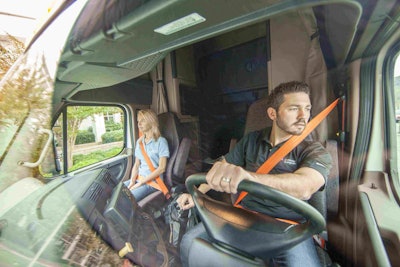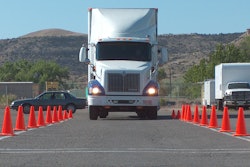 The driver training rule requires all Class A CDL applicants to be trained by an FMCSA-approved trainer.
The driver training rule requires all Class A CDL applicants to be trained by an FMCSA-approved trainer.New training standards for entry-level truck operators have been finalized by the U.S. Department of Transportation and will become requirements on February 7, 2020. The rule officially becomes law February 6, 2017, allowing a three-year grace period for carriers, trainers and others to prepare for the February 2020 compliance date.
The DOT’s Federal Motor Carrier Safety Administration will publish December 8 the new rule establishing the training standards, which encompass both a core classroom curriculum and behind-the-wheel training requirements.
The rule also establishes a registry of FMCSA-approved trainers that entry-level truckers must use to receive their training. The rule establishes separate standards for Class A and Class B CDL trainees, as well as requirements for endorsements like hazmat and passenger.
The rule has received industry-wide support, from major trucking lobbyists like the American Trucking Associations and the Owner-Operator Independent Drivers Association to safety advocate groups. The rule only applies to CDL applicants who have not received their CDL by February 7, 2020.
As a key departure from the agency’s March 2016-issued proposed rule, FMCSA nixed the requirement that truckers undergo 30 hours of behind-the-wheel training before being eligible to receive their Commercial Driver’s License. The rule still requires behind-the-wheel range training and public road training, but it does not require a minimum number of hours. Trainees successfully complete their behind-the-wheel training when “all elements of the curricula [are] proficiently demonstrated while the driver-trainee has actual control of the power unit during a driving lesson.”
Likewise, the agency does not require a minimum amount of classroom time, but simply requires training providers to cover the full scope of the core curriculum set by the rule.
Required curricula items for Class A CDL include basic operation of a vehicle, vehicle control systems and dashboard instruments, pre- and post-trip inspections, backing and docking, coupling and uncoupling, distracted driving, use of signals and other vehicle communication, emergency situations, roadside inspections, truck maintenance, handling cargo, hours of service, wellness, post-crash procedures, trip planning and more.
Behind-the-wheel training requirements cover a similar set of required training activities.
The classroom element and the driving elements must be administered by an FMCSA-approved provider from the Training Provider Registry established by the rule. States’ licensing agencies must electronically certify CDL applicants have completed proper training before allowing them to take the skills test required to receive a CDL.
The agency outlines in the rule procedures for trainers to apply and be approved for the Training Provider Registry. Carriers who offer their own in-house training can still do so, but they must go through the same procedure as training schools and other entities to be added to the registry. Individuals can also train friends and family members, but they must also be verified by FMCSA to do so.
FMCSA estimates the total cost of the rule to the trucking industry will total $3.67 billion by 2029, equating to about $366 million annually from the 2020 compliance date. The agency estimates those costs will be partially offset by a $2.389 billion benefit to the industry, coming by way of more efficient truck operation, fewer crashes and lower maintenance and repair costs.












